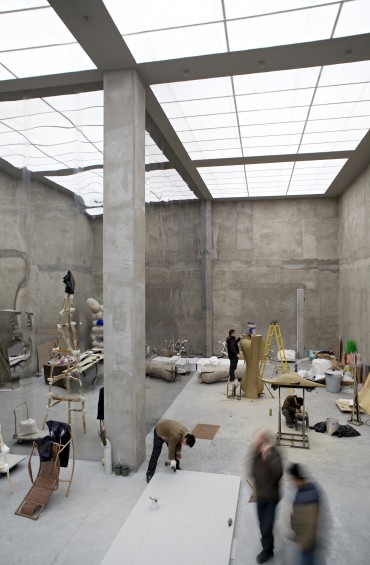
Atelier Not Vital by Mitsunori Sano
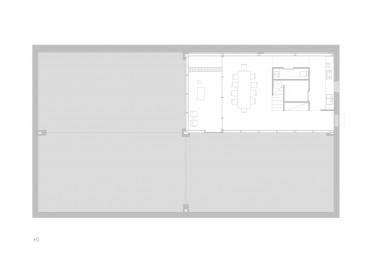
Ground floor
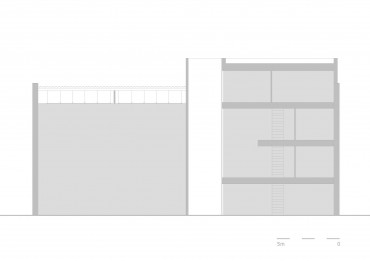
Section

House to watch sunset, Agadez (Niger), Not Vital
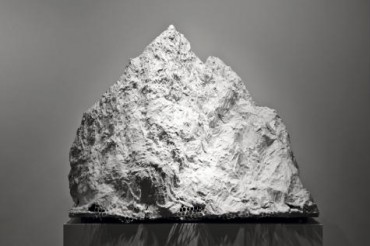
Pis Ajüz, Not Vital

traditional Chinese art made out of Dali Stone
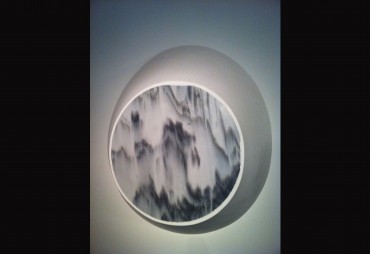
Not Vital
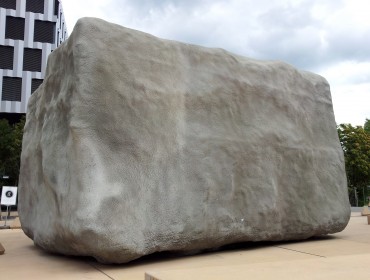
No problem sculpture, Zurich, Not Vital
16.7.2014 – Issue 11 - Made In China – Hotz Anna, Vital Not, Sano Mitsunori – Interviews, Videos
ART AND ARCHITECTURE - Atelier Not Vital in Beijing
Interview with Not Vital and Mitsunori Sano
Not Vital was born in 1948 in Sent, Graubünden (CH) and has been living and working between the USA, Africa, Chile, Italy and Switzerland.
In 2008 he commissioned his collaborator, the young Japanese architect Mitsunori Sano, to design his new Atelier in Caochangdi, an artist neighbourhood of Beijing.
Mitsunori Sano succeeds to combine the two different functions of living and working in the same place in a surprising way. Exactly a quarter of the volume is defined as living area. The separation walls made out of stainless steel work as mirrors. The mirror effect let vanish the private living part and gives the illusion that the room is still an entire rectangle with a central pillar.
Not Vital,
has your art been influenced by living and working in China?
NOT VITAL: My art has been influenced especially by the production, which is not always positive. Here you are producing a lot, the production of my sculpture also became enormous. You can produce very big pieces. Like an ‘enfant terrible’ one tries always to do something bigger.
Mitsunori Sano,
could you explain the architectural concept for the art studio of Not Vital?
MITSUNORI SANO: In 2008 I came the first time to China with Not to see his sculpture, which was produced in a factory of stainless steel. This was the beginning, so the idea was to do something with this material ‘stainless steel’. I asked myself how could I use this material for the studio of Not Vital and I decided to use it like an enormous mirror, never seen in my life.
Not Vital,
you like to collaborate with architects. Why are you interested in the interaction of art and architecture?
NOT VITAL: I think, that the gap between art and architecture is narrowing. Here in Beijing some buildings like the birds nest or the CCTV they are a sculpture themselves. Different from architecture in the 60ties, you have a bank in downtown New York for example, where you see a building and a plaza in front of it. So the plaza in front was actually meant to put a sculpture on it, for example a ‘Dubuffet’. Now the building is already a sculpture itself. I was thinking sometimes, what sculpture could you put in front of the CCTV? You can’t. It’s kind of like the same thing trying to put a sculpture in front of a building of Gaudì.
A very important part of my creation is now architecture – I think is architecture, I don’t even know – because I can’t design a house with running water. The house I designed in Africa is only to watch the sunset.
Mitsunori Sano,
you have been working with Not for many years. How does this influence your work as an architect?
MITSUNORI SANO: I studied in Mendisio. Mendisio is already different from other schools. The education we got goes towards art. After that, I went to work for Not Vital and I got a lot of inputs from different artists, especially from him. This influenced me a lot. I think now that usually architecture with all its perfect materials and its perfect details is too serious. It needs something more to make the life more liveable. Sometimes Not makes sculpture that make you laugh. There is not a lot of architecture that makes you laugh. It is always too serious. I would like to go in this direction where architecture can make one laugh.
On our trip we were trying to find out, whether there is a tendency in contemporary Chinese architecture to refer to the Chinese tradition. Not Vital, can you see this phenomenon in Chinese art?
NOT VITAL: What happens in the art world, there are a lot of people coming to Beijing. They have maybe a catalogue of Richter. They study Richter, they paint Richter and then eventually they have to do their own work. So they have to start off with something that everybody knows. This transition goes quite fast. If you meet him one month later he is not painting Richter anymore, he is doing something of his own. It takes some time until you go back to your roots. That’s very common. It took me twenty years to realize that I could make a sculpture of the mountain in front of me. I have seen this mountain since I was born.
With China it is the same thing. You open up and you have all the opportunities, especially in architecture. If you can have this phenomenal stadium, you built it. I think eventually it will go back to the roots and it is going to be more traditional. It went to one extreme but it might swing back to the other extreme. You see this architecture here in Beijing. But did you ask what people think of the CCTV? People don’t like it so much. The CCTV has a nickname, it’s called the pants.
You have done a piece of art out of marble, which refers a lot to traditional Chinese art. Can you explain it?
NOT VITAL: It is called ‘Dali stone’. It was used in the 18th century integrated in chairs and tables. What I’m fascinated about it is that you can simply take a stone and cut it and inside you find something. It’s phenomenal, it’s like buying a lottery. Usually they are landscapes. Most of what you find in these stones is exactly what you find outside. Landscapes, the mountain around Dali, you find them in the stones in a smaller size. And having this frames – I was not aware at the beginning – till somebody said it is like looking out of a window in Engadin.
You work in different countries to get new inspirations. Your art often deals with the regional tradition and it reflects the local habits. Last year you won a competition for a sculpture in Zürich in front of the Mobimo tower. Why is it called ‘no problem sculpture’ and how does it refer to the place?
NOT VITAL: I took this block of clay which I had and said let’s do something with clay. I put it on the table and that was it. I said how tall is the Mobimo tower, it is 81 meters. So the twelve sides of this cube let’s add it up to 81 meters. That was the concept.
Regarding the name of the sculpture. I have to say I’m sick of problems! I don’t use the word problem anymore ever since I have been to Africa, because there you can never hear it. Once I asked my friend, why do I never hear you using the word problem? He said ‘because we don’t have‘. In Switzerland you hear it all the time. I’m sick and tired to hear ‘the problem is this and that….’ The whole thing is a problem! We have no problems! And he said ‘a problem is if you have ten children and you have only this much rice. That’s a problem’.
So that’s why I built something for Zurich, which is called the ‘no problem sculpture’. No problem, it’s not big, it’s not small, it’s not beautiful, it’s not ugly, you can piss on it, you can climb it, you can spray it, …. the project can be accepted or rejected – no problem!
Interview by Anna Hotz, Cecilia Obiol and Huang Xuseng during seminar week of the Chair of Prof. Dr. Josep Lluís Mateo to Beijing and Pingyao.
Download article as PDF

